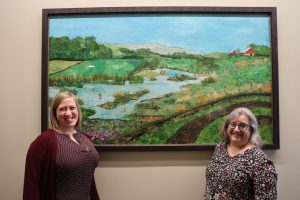Merging Art and Science: Wetland Art Shares a Message of Community and Sustainability in ABE
Author: Sarah Hays
Author: Sarah Hays

When traveling through the halls of Sukup and Elings, the message of sustainability and conservation is often shown through artwork, posters and more. Recently, the building received an original piece of art to add to the walls – now hanging on the fourth floor of Elings Hall.
This piece of art was initially designed for the exterior of the Conservation Station ‘Marsh Madness’ trailer, a trailer created through the Iowa Learning Farms and Water Rocks! programs dedicated to wetland education and outreach across the state. In order to create the art for the trailer, an original design needed to be created on a large surface that could later be photographed and enlarged to fit on the trailer – and that is exactly what artist Cecelia Comito and Iowa State University Department of Agricultural and Biosystems Engineering program specialist Ann Staudt did.
In the initial phase of designing this art, Comito analyzed all of the different Iowa wetlands in order to create art that accurately represented a wetland in Iowa. For Comito, accurately representing an Iowa wetland also meant taking into consideration the relationship between wetlands and Iowans.
“I wanted to capture the harmony of the relationship that can exist between wetlands and farms in this piece,” Comito said. “Just because you are in favor of supporting our wetlands, doesn’t mean that they have to happen at the expense of farming and raising animals. That has always been important to me – showing how these things can co-exist and benefit each other. I think that is also a part of the big mission of the Iowa Learning Farms.”
Not only does this artwork represent sustainability, but it was also created using sustainable, local materials.
“This piece of work is a collage – so the papers used in it are primarily old magazine papers, book pages, things that would’ve ended up in the landfill,” Comito said. “We have a lot of these kinds of papers, so when I pick the papers, I try to be thoughtful about what papers I am using on it, even though you can’t really see them.”
“In this case, the first layer was all from old farm journals,” she said. “Then, I had some other papers that were from an old German cookbook and some Midwest farming papers. We painted and printed on those papers in a bunch of different colors.”
As Comito builds the layers with different papers, she gets more detailed in the artwork. The top layer mainly consists of natural mulberry and rice papers that she stains with watercolor paints. These papers are textured and often contain natural elements like fragments of wood, leaves and flowers. The colored papers are then used to create details such as grasses and fields.
“As the final step, I go over the piece and add things to make the art read like a landscape – adding some paint, textures or stamping,” Comito said. “I added a light blue wash on the sky to push it back a little – things like that.”
The four by six foot collage is the largest piece of art that Comito has ever created – and the process took quite a while, as well. Staudt and Comito dedicated several months to this project, including Staudt working with Comito once a week in her studio, Artworks Studio, in Carroll, Iowa.
“During the main artwork production period in early 2021, I traveled to Carroll one day per week to roll up my sleeves for some serious hands-on art time with Cecelia, and we would be in close communication via text and email as she continued working on the piece in the interim,” Staudt said. “It was a pretty epic undertaking—nearly eight months start-to-finish! We began the planning process in October 2020. Hands-on work on this piece, as well as four other smaller mixed media pieces for the Marsh Madness trailer, spanned from January to April of 2021.”
Installation of the Marsh Madness collage at Elings Hall was the perfect location for it, according to Staudt. The goal is for this artwork to inspire others and build awareness around wetlands with education and conservation in mind, Staudt said.
“Constructed wetlands, also referred to as water quality enhancement wetlands, are at the interface of science, engineering and the natural world,” Staudt said. “To me, that hits right at the heart of what we do in ABE – implementing science and engineering solutions to support the long-term sustainability of our land and water. With extension programs like Iowa Learning Farms and Water Rocks!, our mission is taking the science and research out to the people – and art is a powerful tool in forming a creative and engaging delivery of those messages.”
In addition to the piece hanging in Elings Hall, Staudt and Comito created four other panels for the Conservation Station Marsh Madness trailer that depict closeups of common sites on Iowa’s wetlands, including swans, muskrats, turtles and other reptiles, and butterflies.
In the future, this artwork may be available to purchase in print form. Comito earned her bachelor’s degree in journalism at Iowa State and a law degree from the University of Iowa College of Law. She didn’t seriously pursue her interest in art until she retired and moved back to Iowa to work with her sister, Laura, at Artworks Studio in Carroll, Iowa at https://www.artworksstudio.art/.